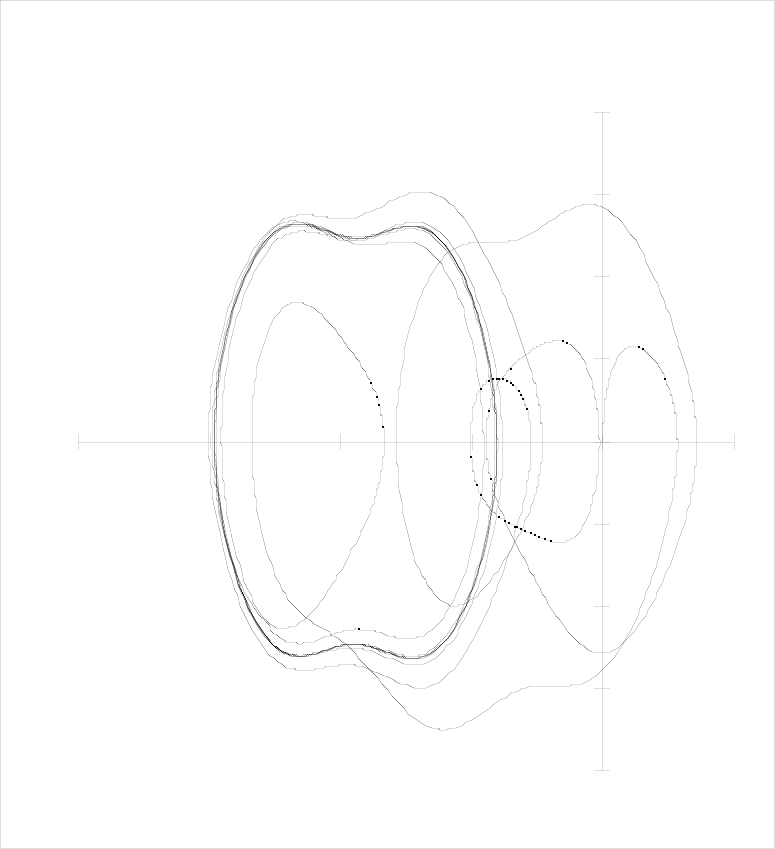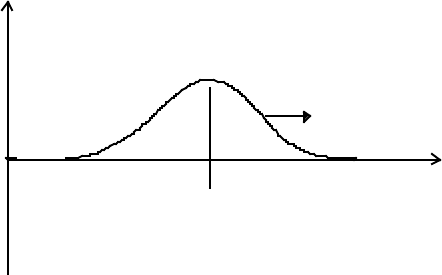Firk F.W.K. Essential Physics. Part 1. Relativity, Particle Dynamics, Gravitation, and Wave Motion
Подождите немного. Документ загружается.

C H A O S 163
chaotic. Periodic motion is characterized by closed orbits in the (θ - ω) plane. If the
damping is reduced considerably, the motion can become highly chaotic.
The system is sensitive to small changes in the initial conditions. The trajectories
in phase space diverge from each other with exponential time-dependence. For chaotic
motion, the projection of the trajectory in (θ, ω, φ) - space onto the (θ - ω) plane
generates trajectories that intersect. However, in the full 3 - space, a spiralling line along
the φ-axis never intersects itself. We therefore see that chaotic motion can exist only
when the system has at least a 3 - dimensional phase space. The path then converges
towards the attractor without self-crossing.
Small changes in the initial conditions of a chaotic system may produce very
different trajectories in phase space. These trajectories diverge, and their divergence
increases exponentially with time. If the difference between trajectories as a function of
time is d(t) then it is found that logd(t) ~ λt or
d(t) ~ e
λt
(11.9)
where λ > 0 - a positive quantity called the Lyapunov exponent. In a weakly chaotic
system λ << 0.1 whereas, in a strongly chaotic system, λ >> 0.1.
11.2 The numerical solution of differential equations
A numerical method of solving linear differential equations that is suitable in the
present case is known as the Runge-Kutta method. The algorithm for solving two
equations that are functions of several variables is:
Let
C H A O S 164
dy/dx = f(x, y, z) and dz/dx = g(x, y, z). (11.10)
If y = y
0
and z = z
0
when x = x
0
then, for increments h in x
0
, k in y
0
, and l in z
0
the Runge-Kutta equations are
k
1
= hf(x
0
, y
0
, z
0
) l
1
= hg(x
0
, y
0
, z
0
)
k
2
= hf(x
0
+ h/2, y
0
+ k
1
/2, z
0
+ l
1
/2) l
2
= hg(x
0
+ h/2, y
0
+ k
1
/2, z
0
+ l
1
/2)
k
3
= hf(x
0
+ h/2, y
0
+ k
2
/2, z
0
+ l
2
/2) l
3
= hg(x
0
+ h/2, y
0
+ k
2
/2, z
0
+ l
2
/2)
k
4
= hf(x
0
+ h, y
0
+ k
3
, z
0
+ l
3
) l
4
= hg(x
0
+ h, y
0
+ k
3
, z
0
+ l
3
)
k = (k
1
+ 2k
2
+ 2k
3
+ k
4
)/6
and
l = (l
1
+ 2l
2
+ 2l
3
+ l
4
)/6. (11.11)
The initial values are incremented, and successive values of the x, y, and z are generated
by iterations. It is often advantageous to use varying values of h to optimize the
procedure.
In the present case,
f(x, y, z) → f(t, θ, ω) and g(x, y, z) → g(ω).
As a problem, develop an algorithm to solve the non-linear equation 11.5 using the
Runge-Kutta method for three equations (11.6, 11.7, and 11.8). Write a program to
calculate the necessary iterations. Choose increments in time that are small enough to
reveal the details in the θ-ω plane. Examples of non-chaotic and chaotic behavior are
shown in the following two diagrams.

C H A O S 165
Points in the θ-ω plane for a non-chaotic system
-200
-150
-100
-50
0
50
100
150
200
-400 -300 -200 -100 0 100
θ
ω
The parameters used to obtain this plot in the θ-ω plane are :
damping factor (1/q) = 1/5,
amplitude (C) = 2,
drive frequency (ω
D
) = 0.7, and
time increment, ∆t = 0.05.
All the initial values are zero.

C H A O S 166
Points in the θ-ω plane for a chaotic system
-100
-80
-60
-40
-20
0
20
40
60
80
100
-60 -40 -20 0 20 40 60
θ
ω
The parameters used to obtain this plot in the θ-ω plane are:
damping factor (1/q) = 1/2,
amplitude (C) = 1.15,
drive frequency (ω
D
) = 0.597, and
time increment, ∆t = 1.
The intial value of the time is 100.

12
WAVE MOTION
12.1 The basic form of a wave
Wave motion in a medium is a collective phenomenon that involves local
interactions among the particles of the medium. Waves are characterized by:
1) a disturbance in space and time.
2) a transfer of energy from one place to another,
and
3) a non-transfer of material of the medium.
(In a water wave, for example, the molecules move perpendicularly to the velocity
vector of the wave).
Consider a kink in a rope that propagates with a velocity V along the +x-axis, as
shown
y
Displacement
V , the velocity of the waveform
x
x at time t
Assume that the shape of the kink does not change in moving a small distance ∆x in a short
interval of time ∆t. The speed of the kink is defined to be V = ∆x/∆t. The displacement
in the y-direction is a function of x and t,
W A V E M O T I O N 168
y = f(x, t).
We wish to answer the question: what basic principles determine the form of the argument
of the function, f ? For water waves, acoustical waves, waves along flexible strings, etc. the
wave velocities are much less than c. Since y is a function of x and t, we see that all points
on the waveform move in such a way that the Galilean transformation holds for all inertial
observers of the waveform. Consider two inertial observers, observer #1 at rest on the x-
axis, watching the wave move along the x-axis with constant speed, V, and a second
observer #2, moving with the wave. If the observers synchronize their clocks so that
t
1
= t
2
= t
0
= 0 at x
1
= x
2
= 0, then
x
2
= x
1
– Vt.
We therefore see that the functional form of the wave is determined by the form of the
Galilean transformation, so that
y(x, t) = f(x – Vt), (12.1)
where V is the wave velocity in the particular medium. No other functional form is
possible! For example,
y(x, t) = Asink(x – Vt) is permitted, whereas
y(x, t) = A(x
2
+ V
2
t) is not.
If the wave moves to the left (in the –x direction) then
y(x, t) = f(x + Vt). (12.2)
We shall consider waves that superimpose linearly. If, for example, two waves
move along a rope in opposite directions, we observe that they “pass through each other”.
W A V E M O T I O N 169
If the wave is harmonic, the displacement measured as a function of time at the origin,
x = 0, is also harmonic:
y
0
(0, t) = Acos(ωt)
where A is the maximum amplitude, and ω = 2πν is the angular frequency.
The general form of y(x, t), consistent with the Galilean transformation, is
y(x, t) = Acos{k(x – Vt)}
where k is introduced to make the argument dimensionless (k has dimensions of
1/[length]). We then have
y
0
(0, t) = Acos(kVt) = Acos(ωt).
Therefore,
ω = kV, the angular frequency, (12.3)
or
2πν = kV,
so that,
k = 2πν/V = 2π/VT where T = 1/ν, is the period. (12.4)
The general form is then
y(x, t) = Acos{(2π/VT)(x – Vt)}
= Acos{(2π/λ)(x – Vt)}, where λ = VT is the wavelength,
= Acos{(2πx/λ – 2πt/T)},
= Acos(kx – 2πt/T), where k = 2π/λ, the “wavenumber”,
= Acos(kx – ωt),
W A V E M O T I O N 170
= A cos(ωt – kx), because cos(–θ) = cos(θ). (12.5)
For a wave moving in three dimensions, the diplacement at a point x, y, z at time t has the
form
ψ(x, y, z, t) = Acos(ωt – k⋅r), (12.6)
where |k| = 2π/λ and r = [x, y, z].
12.2 The general wave equation
An arbitrary waveform in one space dimension can be written as the superposition
of two waves, one travelling to the right (+x) and the other to the left (–x) of the origin.
The displacement is then
y(x, t) = f(x – Vt) + g(x + Vt). (12.7)
Put
u = f(x – Vt) = f(p), and v = g(x + Vt) = g(q),
then
y = u + v .
Now,
∂y/∂x = ∂u/∂x + ∂v/∂x = (du/dp)(∂p/∂x) + (dv/dq)(∂q/∂x)
= f´(p)(∂p/∂x) + g´(q)(∂q/∂x).
Also,
∂
2
y/∂x
2
= (∂/∂x){(du/dp)(∂p/∂x) + (dv/dq)(∂q /∂x)}
= f´(p)(∂
2
p/∂x
2
) + f´´(p)(∂p/∂x)
2
+ g´(q)(∂
2
q/∂x
2
) + g´´(q)(∂q/∂x)
2
.
We can obtain the second derivative of y with respect to time using a similar method:
W A V E M O T I O N 171
∂
2
y/∂t
2
= f´(p)(∂
2
p/∂t
2
) + f´´(p)(∂p/∂t)
2
+ g´(q)(∂
2
q/∂t
2
) + g´´(q)(∂q/∂t)
2
.
Now, ∂p/∂x = 1, ∂q/∂x = 1, ∂p/∂t = –V, and ∂q/∂t = V, and all second derivatives are
zero (V is a constant). We therefore obtain
∂
2
y/∂x
2
= f’´´(p) + g´´(q),
and
∂
2
y/∂t
2
= f’´´(p)V
2
+ g´´(q)V
2
.
Therefore,
∂
2
y/∂t
2
= V
2
(∂
2
y/∂x
2
).
or
∂
2
y/∂x
2
– (1/V
2
)(∂
2
y/∂t
2
) = 0. (12.8)
This is the wave equation in one-dimensional space. For a wave propagating in three-
dimensional space, we have
∇
2
ψ – (1/V
2
)(∂
2
ψ/∂t
2
) = 0, (12.9)
the general form of the wave equation, in which ψ(x, y, z, t) is the general amplitude
function.
12.3 The Lorentz invariant phase of a wave and the relativistic Doppler shift
A wave propagating through space and time has a “wave function”
ψ(x, y, z, t) = Acos(ωt – k⋅r)
where the symbols have the meanings given in 12.2.
The argument of this function can be written as follows
ψ = Acos{(ω/c)(ct) – k⋅r). (12.10)

W A V E M O T I O N 172
It was not until deBroglie developed his revolutionary idea of particle-wave duality in
1923-24 that the Lorentz invariance of the argument of this function was fully appreciated!
We have
ψ = Acos{[ω/c, k]
T
[ct, –r]}
= Acos{K
µ
E
µ
} = Acosφ, where φ is the “phase”. (12.11)
deBroglie recognized that the phase φ is a Lorentz invariant formed from the 4-vectors
K
µ
= [ω/c, k], the “frequency-wavelength” 4-vector, (12.12)
and
E
µ
= [ct, –r], the covariant “event” 4-vector.
deBroglie’s discovery turned out to be of great importance in the development of
Quantum Physics. It is also provides us with the basic equations for an exact derivation of
the relativistic Doppler shift. The frequency-wavelength vector is a Lorentz 4-vector,
which means that it transforms between inertial observers in the standard way:
K
µ
´ = LK
µ
, (12.13)
or
ω´/c γ –βγ 0 0 ω/c
k
x
´ –βγ γ 0 0 k
x
k
y
´ = 0 0 1 0 k
y
k
z
´ 0 0 0 1 k
z
The transformation of the first element therefore gives
ω´/c = γ(ω/c) – βγk
x
. (12.14)
therefore
